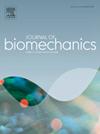A novel markerless gait analysis method to detect alterations in inter-joint coupling patterns of human foot during cross-slope walking
IF 2.4
3区 医学
Q3 BIOPHYSICS
引用次数: 0
Abstract
Walking on uneven surfaces alters foot joint kinematics and challenges gait stability. The intricate joint coupling relationship of the human foot, which is essential for biomechanical adaptations, particularly when encountering uneven surfaces, remains unclear. This study focused on quantifying foot joint coordination on cross-slopes using a markerless gait analysis method. Twelve healthy subjects performed walking tests on a gait platform under level, 8° everted and 8° inverted surface conditions. Segmental motion between rearfoot, midfoot, forefoot, and hallux were analyzed using a point cloud-based multi-segment foot model (MSFM). Adaptive changes of multi-segmental foot kinematics and inter-joint coupling relationships were compared across different cross-slope conditions. The results indicated that the rearfoot dominated frontal plane motion during everted surface walking in both middle and late stance, while the forefoot and midfoot dominated during inverted surface walking, respectively. In contrast to level walking, the sagittal-plane motion of the midtarsal joints during everted and inverted surface walking did not significantly contribute to foot kinematics at push-off. Further analysis reveals that significant variabilities exist in joint coupling behavior at different phases of the cross-slope walking.These findings demonstrate the effectiveness of the proposed method in detecting the complex inter-joint kinematics and coupling patterns of the human foot during cross-slope walking. The results provide insights into the kinematic changes of foot joints for terrain adaptation in uneven walking surfaces and advocate the application of novel motion analysis methods for tracking natural gait patterns.
一种新的无标记步态分析方法来检测人足在跨坡行走时关节间耦合模式的变化
在不平坦的地面上行走会改变足关节的运动学,并挑战步态的稳定性。人类足部复杂的关节耦合关系对生物力学适应至关重要,特别是在遇到不平整的表面时,目前尚不清楚。本研究的重点是使用无标记步态分析方法量化跨坡时的足关节协调性。12名健康受试者在水平、8°倾斜和8°倒置表面条件下的步态平台上进行行走测试。采用基于点云的多段足部模型(MSFM)分析后足、中足、前足和拇趾之间的节段运动。比较了不同横坡条件下多节段足部运动学和关节间耦合关系的自适应变化。结果表明:倒立面行走中、后期站立时,前平面运动以后脚为主,倒立面行走中,前平面运动以前脚为主;与水平行走相比,仰角和倒面行走时跗骨中关节矢状面运动对蹬离时足部运动学没有显著影响。进一步分析表明,在跨坡行走的不同阶段,节理耦合行为存在显著差异。这些结果证明了该方法在检测人体足部在跨坡行走时复杂的关节间运动学和耦合模式方面的有效性。研究结果揭示了在不平坦的行走路面上足关节的运动学变化以适应地形,并倡导应用新颖的运动分析方法来跟踪自然步态模式。
本文章由计算机程序翻译,如有差异,请以英文原文为准。
求助全文
约1分钟内获得全文
求助全文
来源期刊

Journal of biomechanics
生物-工程:生物医学
CiteScore
5.10
自引率
4.20%
发文量
345
审稿时长
1 months
期刊介绍:
The Journal of Biomechanics publishes reports of original and substantial findings using the principles of mechanics to explore biological problems. Analytical, as well as experimental papers may be submitted, and the journal accepts original articles, surveys and perspective articles (usually by Editorial invitation only), book reviews and letters to the Editor. The criteria for acceptance of manuscripts include excellence, novelty, significance, clarity, conciseness and interest to the readership.
Papers published in the journal may cover a wide range of topics in biomechanics, including, but not limited to:
-Fundamental Topics - Biomechanics of the musculoskeletal, cardiovascular, and respiratory systems, mechanics of hard and soft tissues, biofluid mechanics, mechanics of prostheses and implant-tissue interfaces, mechanics of cells.
-Cardiovascular and Respiratory Biomechanics - Mechanics of blood-flow, air-flow, mechanics of the soft tissues, flow-tissue or flow-prosthesis interactions.
-Cell Biomechanics - Biomechanic analyses of cells, membranes and sub-cellular structures; the relationship of the mechanical environment to cell and tissue response.
-Dental Biomechanics - Design and analysis of dental tissues and prostheses, mechanics of chewing.
-Functional Tissue Engineering - The role of biomechanical factors in engineered tissue replacements and regenerative medicine.
-Injury Biomechanics - Mechanics of impact and trauma, dynamics of man-machine interaction.
-Molecular Biomechanics - Mechanical analyses of biomolecules.
-Orthopedic Biomechanics - Mechanics of fracture and fracture fixation, mechanics of implants and implant fixation, mechanics of bones and joints, wear of natural and artificial joints.
-Rehabilitation Biomechanics - Analyses of gait, mechanics of prosthetics and orthotics.
-Sports Biomechanics - Mechanical analyses of sports performance.
 求助内容:
求助内容: 应助结果提醒方式:
应助结果提醒方式:


